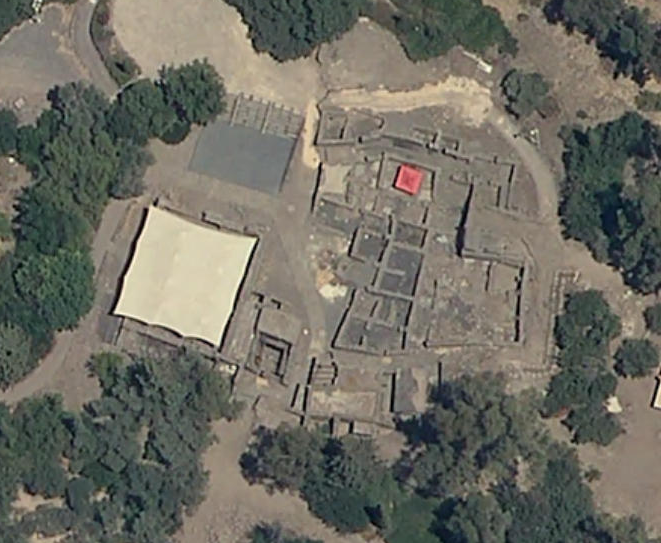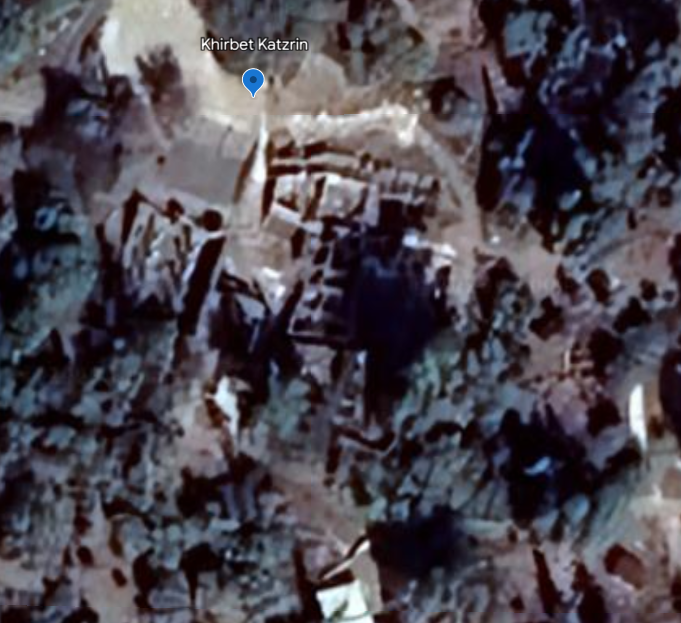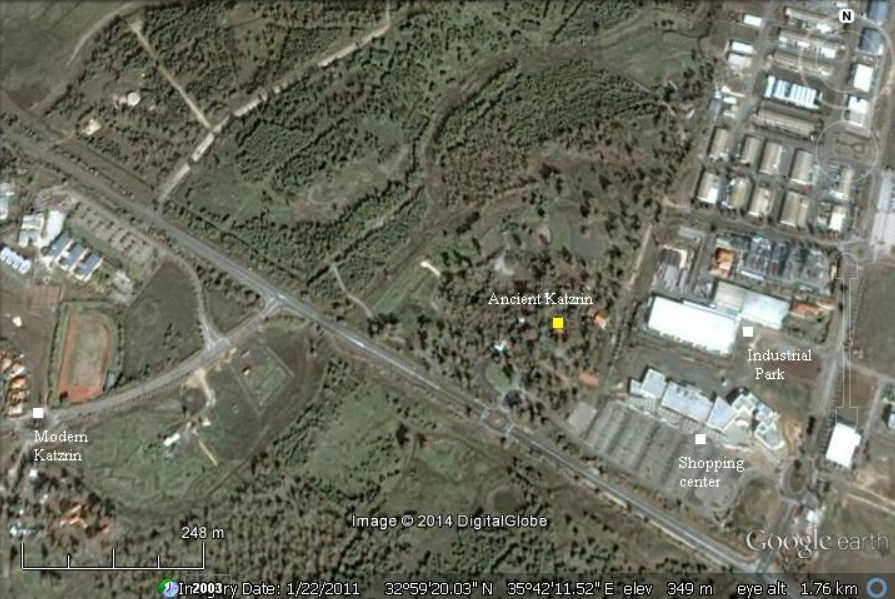Qasrin
| Transliterated Name | Source | Name |
|---|---|---|
| Katzrin | Hebrew | קַצְרִין |
| Qatzrin | Arabic | قصرين |
| Qasrin, Kasrin | other spelling variants | |
The archeological site of Qasrin is located in the central Golan Heights ~ 1 km. southeast of the modern city of Qasrin. The site's ancient name is unknown (Ann Killebrew in Meyers et al, 1997). The site was occupied from the Middle Bronze Age, continuing into the Iron Age, the Hellenistic and Roman periods while the most substantial structural remains date from the Late Roman, Byzantine and Early Islamic periods (3rd–4th to mid-8th centuries), when the site was a Jewish village with a synagogue (Killebrew in Jameson ed., 2004:127-129). Later occupation levels include Mameluke and late 19th century CE. Synagogue B on the site shows evidence of earthquake destruction in the middle of the 8th century CE.
The ancient site of Qasrin is in the central Golan, about 1 km (0.6 mi.) southeast of modern Qasrin, on a low hill with moderate northern and western slopes (map reference 2161.2661). At the edge of the site is a small spring; a winter stream (locally known as Masil Sheikh Musa), with two small underground springs in its bed, runs north of it. Rock-cut burial caves with kokhim (loculi) were found in the hill's cliffs north of the stream. The site is surrounded by extensive fields, and it appears that the ancient inhabitants cultivated fields and olive orchards; two oil presses were found to the west and south of the site.
Qasrin was discovered by G. Schumacher in 1884 and visited by him again in 1913. The synagogue at Qasrin was discovered by S. Gutman in 1967 and surveyed several times by D. Urman from 1969 to 1971. The surveys revealed the synagogue's portal in situ, many architectural remains, and inscriptions, one of which, in Hebrew, was found on a tombstone: רני אנזך משכנך נכנרד (Rabbi Abun, may he rest in honor). In 1971-1972, the synagogue was partly excavated by Urman, on behalf of the archaeology staff officer; in 1975-1976, the excavation of the prayer hall and the adjacent rooms was completed by M. Ben-Ari and S. Barlev. In 1978, a stratigraphic probe was conducted under the synagogue floor by Barlev and Z. Ma'oz. A new series of excavations was carried out in the synagogue from 1982 to 1984, on behalf of the Israel Department of Antiquities and Museums, under the direction of Ma'oz, R. Hachlili, and A. Killebrew. Excavations in the village were begun in 1983, directed by Killebrew. An area of about 1,250 sq m was cleared in the northern part of the village, including the synagogue and domestic buildings.
- Qatzrin in Google Earth
- Qatzrin on govmap.gov.il
- Annotated Aerial View of Qatzrin
from BibleWalks.com
- Aerial View of excavated
Synagogue/Mosque from Moaz and Killebrew (1988)

 The synagogue as viewed from the west in 1983. Note the thirteenth-century platform outside of the mosque;
this was used for prayer in the summer. Photograph by Zvi Macoz.
The synagogue as viewed from the west in 1983. Note the thirteenth-century platform outside of the mosque;
this was used for prayer in the summer. Photograph by Zvi Macoz.
Moaz and Killebrew (1988) - Aerial View of excavated Village
at Qasrin from Moaz and Killebrew (1988)

 Aerial View of excavated Village
Aerial View of excavated Village
Moaz and Killebrew (1988)
- Plan of the Synagogue from
Stern et. al. (1993 v.4)

 Plan of the Synagogue
Plan of the Synagogue
Stern et. al. (1993 v.4) - Plan of the Village from
Stern et. al. (1993 v.4)

 Plan of the Village
Plan of the Village
Stern et. al. (1993 v.4) - Plan of Houses A, B, and C
and Synagogue B from Moaz and Killebrew (1988)


In order to gain a better understanding of the wider cultural context of the synagogue, a 1,200-squaie-meter segment east of it has been opened to excavation. Thus far a small public square, three domestic buildings, three industrial rooms, and four alleys have been identified, with only house A having been completely excavated. House A is a small two-room dwelling; its large room was built shortly after the construction of synagogue A and its small room was added in the fifth or sixth century C.E. Alleys separate house A from B and C, and B and C from each other. Four large rooms of house B have been excavated; all of these appear to be additions to an original house, the main part of which lies south of the current excavation boundaries. 7b the east of the four rooms is a courtyard divided into different activity areas by an L-shaped wall. Apparently this house was enlarged and remodeled over several generations. House C, which covers an area of 500 square meters and which extends to the east beyond the current limits of excavation, is actually several structures that were joined together. The com¬plex was occupied in the Byzantine period and later, and it includes, in the northeast section of the excavation area, several rooms that surround the point at which an underground spring comes to the surface. It is clear from what has been excavated thus far that, in contrast to the synagogue, which has three stratigraphically definable construction phases that can be under¬stood in terms of community needs, the Byzantine village developed organically according to the needs of the occupants of each structure.
Moaz and Killebrew (1988) - Simplified Plan of Synagogue B
from Moaz and Killebrew (1988)
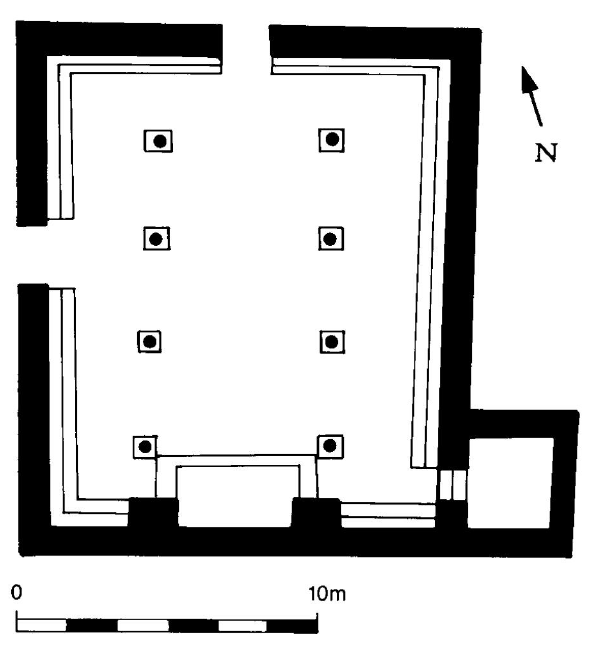
 Simplified plan of the synagogue B at Qasrin. Synagogue B made use of the foundations of the
south, west, and east walls of synagogue A, but the latter two were lengthened to the north and a new foundation for the
north wall was put in place. Note the two-stepped ashlar benches along all four walls, the small annex room, the platform
for a Torah shrine on the south wall (so that prayers could be directed toward Jerusalem), and the main entrance on the
north wall.
Simplified plan of the synagogue B at Qasrin. Synagogue B made use of the foundations of the
south, west, and east walls of synagogue A, but the latter two were lengthened to the north and a new foundation for the
north wall was put in place. Note the two-stepped ashlar benches along all four walls, the small annex room, the platform
for a Torah shrine on the south wall (so that prayers could be directed toward Jerusalem), and the main entrance on the
north wall.
Moaz and Killebrew (1988) - Plan of destruction debris in
Synagogue B from Moaz and Killebrew (1988)


Synagogue B was destroyed by an earthquake, as revealed by the relatively undisturbed destruction debris in its southern section. Note that two column bases of the western row (on the right) and two of the eastern row were found in situ and that most of the architectural members fell in the same direction - towards the northeast: The columns of the western row, including one column shaft 3.7 meters long, were found in the floor of the nave, while those of the eastern row had collapsed into the eastern aisle, with window fragments from the clerestory resting on the benches along the wall. Such a regular pattern of destruction is typical of earthquakes. The destruction has been dated to the eighth century on the basis of pottery sherds from that period found in undisturbed places beneath the destruction layer. The semicircular installation in the wall at the bottom of the drawing is the mihrab of the mosque that was built in the northern part of the structure in the thirteenth century. Walls marked with solid black were original, while those marked with hatching were built for the mosque. Drawing is by M. Feist and A. Kranz
Moaz and Killebrew (1988) - Plan of Mameluke Mosque (~13th c. CE)
from Moaz and Killebrew (1988)
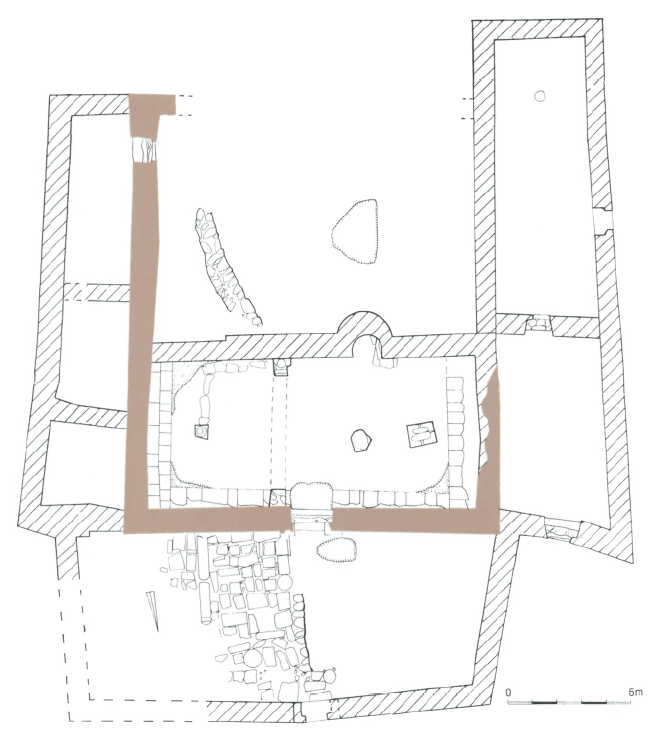
 Plan of the mosque built during the Mamluk period (approximately the thirteenth century C.E.) in the northern section of the ruined synagogue
Plan of the mosque built during the Mamluk period (approximately the thirteenth century C.E.) in the northern section of the ruined synagogue
Drawing by A. Kranz.br>
Moaz and Killebrew (1988)
- Plan of the Synagogue from
Stern et. al. (1993 v.4)

 Plan of the Synagogue
Plan of the Synagogue
Stern et. al. (1993 v.4) - Plan of the Village from
Stern et. al. (1993 v.4)

 Plan of the Village
Plan of the Village
Stern et. al. (1993 v.4) - Plan of Houses A, B, and C
and Synagogue B from Moaz and Killebrew (1988)


In order to gain a better understanding of the wider cultural context of the synagogue, a 1,200-squaie-meter segment east of it has been opened to excavation. Thus far a small public square, three domestic buildings, three industrial rooms, and four alleys have been identified, with only house A having been completely excavated. House A is a small two-room dwelling; its large room was built shortly after the construction of synagogue A and its small room was added in the fifth or sixth century C.E. Alleys separate house A from B and C, and B and C from each other. Four large rooms of house B have been excavated; all of these appear to be additions to an original house, the main part of which lies south of the current excavation boundaries. 7b the east of the four rooms is a courtyard divided into different activity areas by an L-shaped wall. Apparently this house was enlarged and remodeled over several generations. House C, which covers an area of 500 square meters and which extends to the east beyond the current limits of excavation, is actually several structures that were joined together. The com¬plex was occupied in the Byzantine period and later, and it includes, in the northeast section of the excavation area, several rooms that surround the point at which an underground spring comes to the surface. It is clear from what has been excavated thus far that, in contrast to the synagogue, which has three stratigraphically definable construction phases that can be under¬stood in terms of community needs, the Byzantine village developed organically according to the needs of the occupants of each structure.
Moaz and Killebrew (1988) - Plan of destruction debris in
Synagogue B from Moaz and Killebrew (1988)


Synagogue B was destroyed by an earthquake, as revealed by the relatively undisturbed destruction debris in its southern section. Note that two column bases of the western row (on the right) and two of the eastern row were found in situ and that most of the architectural members fell in the same direction - towards the northeast: The columns of the western row, including one column shaft 3.7 meters long, were found in the floor of the nave, while those of the eastern row had collapsed into the eastern aisle, with window fragments from the clerestory resting on the benches along the wall. Such a regular pattern of destruction is typical of earthquakes. The destruction has been dated to the eighth century on the basis of pottery sherds from that period found in undisturbed places beneath the destruction layer. The semicircular installation in the wall at the bottom of the drawing is the mihrab of the mosque that was built in the northern part of the structure in the thirteenth century. Walls marked with solid black were original, while those marked with hatching were built for the mosque. Drawing is by M. Feist and A. Kranz
Moaz and Killebrew (1988) - Plan of Mameluke Mosque
(~13th c. CE) from Moaz and Killebrew (1988)

 Plan of the mosque built during the Mamluk period (approximately the thirteenth century C.E.) in the northern section of the ruined synagogue
Plan of the mosque built during the Mamluk period (approximately the thirteenth century C.E.) in the northern section of the ruined synagogue
Drawing by A. Kranz.br>
Moaz and Killebrew (1988)
- Displaced ashlars in NW
(exterior ?) corner of synagogueStern et. al. (1993 v.4)
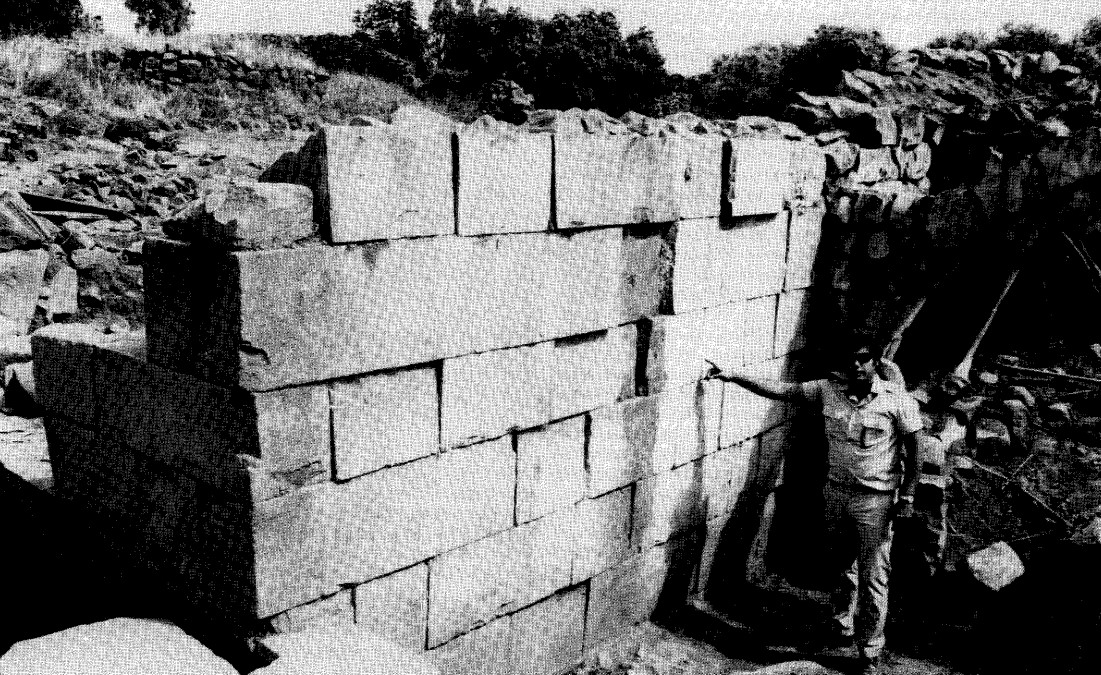
 Ashlar construction in the northwest corner of the Synagogue
Ashlar construction in the northwest corner of the Synagogue
JW: Ashlars are displaced
Zvi Uri Moaz in Stern et al (1993) - Displaced Columns
from Manar Al-Athar (Oxford University)
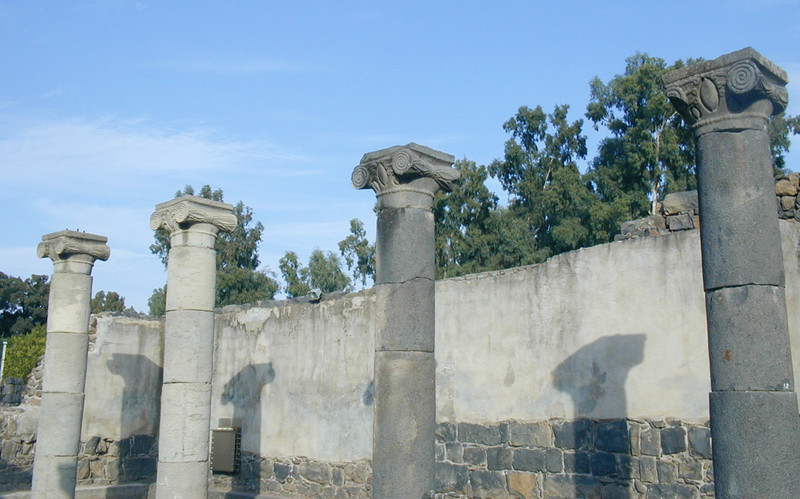
 Photo 05
Photo 05
Column to far right exhibits displaced masonry blocks
Manar Al-Athar website (Oxford University) - Displaced Columns
from Manar Al-Athar (Oxford University)

 Photo 06
Photo 06
Some masonry block column displacement in nearest and farthest columns
Manar Al-Athar website (Oxford University)
| Stratum | Period | Comments |
|---|---|---|
| I | Late nineteenth century-present | cemeteries; reuse of early structures, new structures. |
| IIA-C | Mameluke - 13th-15th Cent. CE | reuse of Byzantine structures; a mosque (building C) in the northern half of the synagogue; houses. |
| III | Early Arab period - mid-8th century CE | renewed, short-lived squatters, occupation of the village. |
| IVB | Late Byzantine and Early Arab periods, 7th-8th centuries CE | extensive repairs to the synagogue; a new plastered floor; floor raising in the houses. |
| IVA | Middle Byzantine period, 6th century CE | erection of the second synagogue (building B); mosaic floor; houses. |
| V | Late Roman and Early Byzantine periods, late 4th-5th centuries CE | erection of the first synagogue (building A) |
| VI | Late Roman period, 3rd-4th centuries CE | building remains; ceramic and numismatic finds. |
| VII | Hellenistic period, 2nd-1st centuries BCE | ceramic finds only. |
| VIII | Iron Age II | hearths, wall fragments and ceramic finds. |
| IX | Middle Bronze Age IIB | ceramic finds only. |
Eisenberg and Osband (2022:154 n. 4) report that there may be evidence from Qasrin for the
419 CE Monaxius and Plinta Quake
however they did not supply supporting evidence.
Eisenberg and Osband (2022:154 n. 4) also report that Qasrin may have been damaged in the 363 CE earthquake.
See
Betlyon and Killebrew (2016) A Fourth-Century CE Coin Hoard from the Qaṣrin Village
, in Viewing Ancient Jewish Art and Archaeology (ed. Ann E. Killebrew and Gabriele Faßbeck)
4 The 418/9 CE earthquake needs further authentication, and in any case, it is unclear whether it affected the region under discussion here. There may be evidence from Qasrin for this earthquake (see below). JW: I did not find supporting evidence below.
This is the only site in the central Golan where both the main public structure of the village-the synagogue-and residential areas have both been excavated. There is continuity at the site from the Middle and possibly Early Roman periods through the Byzantine period. Stratum VI, dated to the 2nd-3rd centuries, contains evidence of domestic buildings as well as ceramic and numismatic finds. Stratum V, dating to the 4th century CE, includes the construction of the first synagogue and the associated residential area (Betylon and Killebrew 2016).
Underneath the 5th- 8th-century floors in the House C insula (Stratum V), domestic units dating to the 4th century were excavated. The finds include restorable vessels dating to the 4th century and numerous 4th-century coin hoards (one hoard contained 8,550 coins). These assemblages contained a variety of ceramic types that differ from those found in nearby Fakhura and Majduliyya. Based on a sample of about 20% (1,608), all but one coin (Hasmonean) are dated to 310-367 CE. The date of the stratum where the hoard was found postdates the 363 CE earthquake according to five of the coins, and it must have been deposited sometime after 367 CE.28 Qasrin serves as a good regional example of post-363 CE settlement continuity.
28 In a small-scale excavation by Zingboym in 2005 (Zingboym 2009) a 4th-century-period occupation was found, based on the pottery and six coins, of which the latest is 383 CE. In an excavation on the western fringe of the village in 2011- 2013 and in 2015, occupation from the Roman and Byzantine periods and later was found which included the 4th century and later.
The site of Deir 'Aziz in the southern Golan was settled in the Roman, Byzantine, and Early Muslim periods. The synagogue's earlier phase was likely destroyed in the earthquake of 363 CE (Ahipaz 2013). Pottery found in the excavation under the synagogue foundations and in the survey suggests that the site was already settled in the 1st-2nd centuries CE and continued at least in part after the Byzantine period into the Abbasid period. An area of pottery production at the site seems to have ceased in the 4th century. The site, like Qasrin, may have been damaged in 363 CE but this did not stop the settlement.
- Plan of destruction debris in
Synagogue B from Moaz and Killebrew (1988)


Synagogue B was destroyed by an earthquake, as revealed by the relatively undisturbed destruction debris in its southern section. Note that two column bases of the western row (on the right) and two of the eastern row were found in situ and that most of the architectural members fell in the same direction - towards the northeast: The columns of the western row, including one column shaft 3.7 meters long, were found in the floor of the nave, while those of the eastern row had collapsed into the eastern aisle, with window fragments from the clerestory resting on the benches along the wall. Such a regular pattern of destruction is typical of earthquakes. The destruction has been dated to the eighth century on the basis of pottery sherds from that period found in undisturbed places beneath the destruction layer. The semicircular installation in the wall at the bottom of the drawing is the mihrab of the mosque that was built in the northern part of the structure in the thirteenth century. Walls marked with solid black were original, while those marked with hatching were built for the mosque. Drawing is by M. Feist and A. Kranz
Moaz and Killebrew (1988) - Plan of Houses A, B, and C
and Synagogue B from Moaz and Killebrew (1988)


In order to gain a better understanding of the wider cultural context of the synagogue, a 1,200-squaie-meter segment east of it has been opened to excavation. Thus far a small public square, three domestic buildings, three industrial rooms, and four alleys have been identified, with only house A having been completely excavated. House A is a small two-room dwelling; its large room was built shortly after the construction of synagogue A and its small room was added in the fifth or sixth century C.E. Alleys separate house A from B and C, and B and C from each other. Four large rooms of house B have been excavated; all of these appear to be additions to an original house, the main part of which lies south of the current excavation boundaries. 7b the east of the four rooms is a courtyard divided into different activity areas by an L-shaped wall. Apparently this house was enlarged and remodeled over several generations. House C, which covers an area of 500 square meters and which extends to the east beyond the current limits of excavation, is actually several structures that were joined together. The com¬plex was occupied in the Byzantine period and later, and it includes, in the northeast section of the excavation area, several rooms that surround the point at which an underground spring comes to the surface. It is clear from what has been excavated thus far that, in contrast to the synagogue, which has three stratigraphically definable construction phases that can be under¬stood in terms of community needs, the Byzantine village developed organically according to the needs of the occupants of each structure.
Moaz and Killebrew (1988)
Moaz and Killebrew (1988) identified two synagogues at the site -
Synagogue A and Synagogue B. They estimated that Synagogue A was first constructed in late 4th century CE. Much of this synagogue was dismantled when Synagogue B was built -
probably in the early 6th century CE. Synagogue B was remodeled likely in the early 7th century CE and appears to have been destroyed
by an earthquake in the mid 8th century CE. The date of the destruction was derived from ceramics from undisturbed loci found beneath the destruction layer.
The ceramics were dated to the end of the 7th and beginning of the 8th century CE.
More earthquake evidence was found in domestic buildings east of the synagogue, which
showed signs of structural destabilization (i.e. partial destruction) dating to the mid-eighth century CE. House C
contained a destruction layer consisting of massive stone tumble and debris on top of the upper pavement where
Moaz and Killebrew (1988)
found pottery sherds dating to the mid-eighth century C.E. Very few
restorable vessels were recovered from this level (stratum III), indicating that when the inhabitants left the site, they took their possessions with them.
| Effect | Location | Image(s) | Description |
|---|---|---|---|
| Displaced Masonry Blocks | Northwest Wall of Synagogue B
 Plan of the Synagogue
Plan of the SynagogueStern et. al. (1993 v.4) 

Moaz and Killebrew (1988) |

 Ashlar construction in the northwest corner of the Synagogue
Ashlar construction in the northwest corner of the SynagogueZvi Uri Moaz in Stern et al (1993) |
from Zvi Uri Ma'oz in Stern et al (1993) |
| Collapsed Walls | Synagogue B
 Plan of the Synagogue
Plan of the SynagogueStern et. al. (1993 v.4) 

Moaz and Killebrew (1988) |


Moaz and Killebrew (1988) |
Some wall collapse seems to be indicated from the stone tumble in Synagogue B - from Moaz and Killebrew (1988) |
| Fallen and Oriented Columns | Synagogue B
 Plan of the Synagogue
Plan of the SynagogueStern et. al. (1993 v.4) 

Moaz and Killebrew (1988) |


Moaz and Killebrew (1988) |
Note that two column bases of the western row (on the right) and two of the eastern row were found in situ and that most of the architectural members fell in the same direction - towards the northeast: The columns of the western row, including one column shaft 3.7 meters long, were found in the floor of the nave, while those of the eastern row had collapsed into the eastern aisle, with window fragments from the clerestory resting on the benches along the wall. Such a regular pattern of destruction is typical of earthquakes.- Moaz and Killebrew (1988) |
| Stone Tumble and debris | House C

Moaz and Killebrew (1988) |
House C contained a destruction layer consisting of massive stone tumble and debris on top of the upper pavement - from Moaz and Killebrew (1988) | |
| Displaced Columns ? (unsure what was restored in these photos) |
Synagogue
 Plan of the Synagogue
Plan of the SynagogueStern et. al. (1993 v.4) 

Moaz and Killebrew (1988) |

 Photo 05
Photo 05Column to far right exhibits displaced masonry blocks Manar Al-Athar website (Oxford University - see references for link) 
 Photo 06
Photo 06Some masonry block column displacement in nearest and farthest columns Manar Al-Athar website (Oxford University - see references for link) |
JW: Columns may be displaced (e.g. like at Jerash). A local site survey and contacting excavators would be a good idea. Based on the drawing of in situ damage at the synagogue, some or possibly all these columns were placed back into a vertical position but the displacements they experienced during the quake may be preserved which, if this is the case, contains local intensity info that might be extractable with mechanical analysis. |
- Modified by JW from Moaz and Killebrew (1988)
- Column falls show a NE orientation
 Deformation Map
Deformation Mapclick on image to open a higher resolution magnifiable image in a new tab
modified by JW from Moaz and Killebrew (1988)
- Earthquake Archeological Effects chart
of Rodríguez-Pascua et al (2013: 221-224)
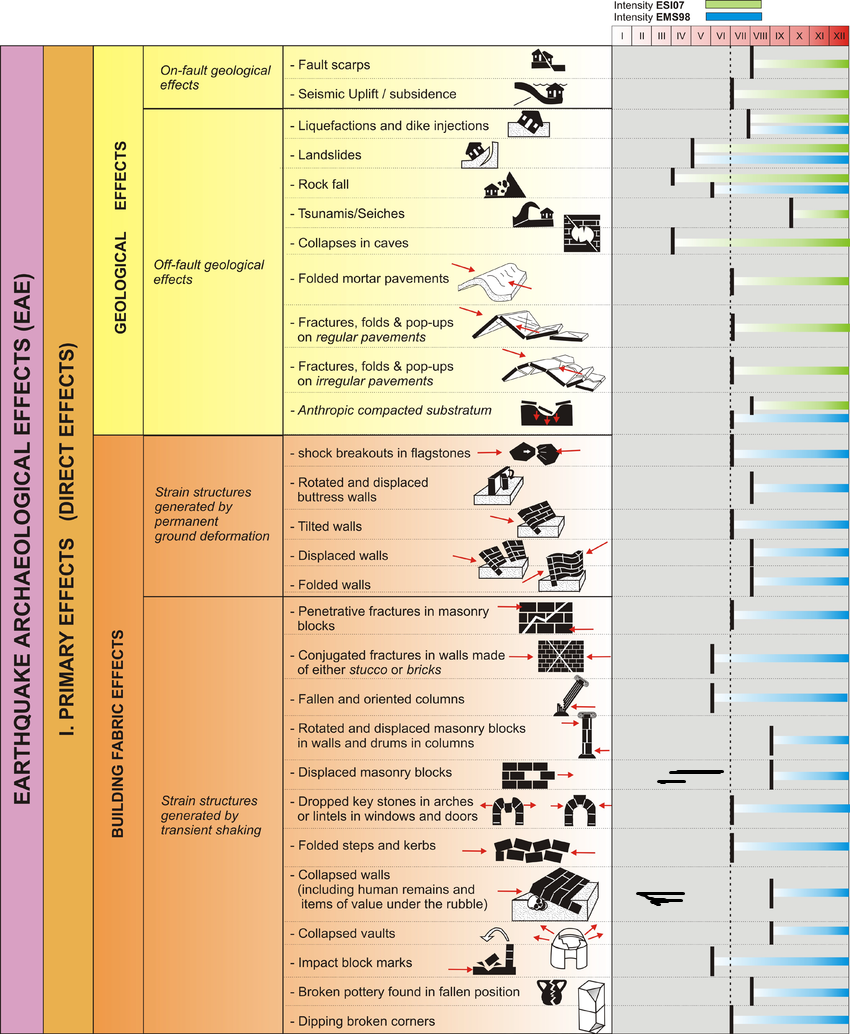
 Earthquake Archeological Effects (EAE)
Earthquake Archeological Effects (EAE)
Rodríguez-Pascua et al (2013: 221-224)
| Effect | Location | Image(s) | Description | Intensity |
|---|---|---|---|---|
| Displaced Masonry Blocks | Northwest Wall of Synagogue B
 Plan of the Synagogue
Plan of the SynagogueStern et. al. (1993 v.4) 

Moaz and Killebrew (1988) |

 Ashlar construction in the northwest corner of the Synagogue
Ashlar construction in the northwest corner of the SynagogueZvi Uri Moaz in Stern et al (1993) |
from Zvi Uri Ma'oz in Stern et al (1993) | VIII + |
| Collapsed Walls | Synagogue B
 Plan of the Synagogue
Plan of the SynagogueStern et. al. (1993 v.4) 

Moaz and Killebrew (1988) |


Moaz and Killebrew (1988) |
Some wall collapse seems to be indicated from the stone tumble in Synagogue B - from Moaz and Killebrew (1988) | VIII + |
| Fallen and Oriented Columns | Synagogue B
 Plan of the Synagogue
Plan of the SynagogueStern et. al. (1993 v.4) 

Moaz and Killebrew (1988) |


Moaz and Killebrew (1988) |
Note that two column bases of the western row (on the right) and two of the eastern row were found in situ and that most of the architectural members fell in the same direction - towards the northeast: The columns of the western row, including one column shaft 3.7 meters long, were found in the floor of the nave, while those of the eastern row had collapsed into the eastern aisle, with window fragments from the clerestory resting on the benches along the wall. Such a regular pattern of destruction is typical of earthquakes.- Moaz and Killebrew (1988) |
V + |
| Stone Tumble and debris which suggests wall collapse | House C

Moaz and Killebrew (1988) |
House C contained a destruction layer consisting of massive stone tumble and debris on top of the upper pavement - from Moaz and Killebrew (1988) | VIII + | |
| Displaced Columns ? (unsure what was restored in these photos) |
Synagogue
 Plan of the Synagogue
Plan of the SynagogueStern et. al. (1993 v.4) 

Moaz and Killebrew (1988) |

 Photo 05
Photo 05Column to far right exhibits displaced masonry blocks Manar Al-Athar website (Oxford University - see references for link) 
 Photo 06
Photo 06Some masonry block column displacement in nearest and farthest columns Manar Al-Athar website (Oxford University - see references for link) |
JW: Columns may be displaced (e.g. like at Jerash). A local site survey and contacting excavators would be a good idea. Based on the drawing of in situ damage at the synagogue, some or possibly all these columns were placed back into a vertical position but the displacements they experienced during the quake may be preserved which, if this is the case, contains local intensity info that might be extractable with mechanical analysis. | VIII + |
most of the architectural members fell in the same direction - towards the northeast.
Betlyon and Killebrew (2016) A Fourth-Century CE Coin Hoard from the Qaṣrin Village
, in Viewing Ancient Jewish Art and Archaeology (ed. Ann E. Killebrew and Gabriele Faßbeck)
Eisenberg, M. and Osband, M. (2022) Evidence for Settlement Decline in Late 3rd–mid-4th Centuries CE in the Hippos Region and Beyond,
Aram v. 34:1 & 2, 153-184
Hassol, E. (2015) Archaeological destruction layers and their contribution to archaeomagnetism,
Archaeoseismology and chrono-stratigraphy Dissertation in Hebrew
Ma'oz , Zvi, and Ann Killebrew. "Ancient Qasrin: Synagogue and Village." Biblical Archaeologist 5 1 (1988) : 5-19.
G. Schumacher, The Jaulan, London 1888, 194
Z. Ma'oz, ASR, 103-105
id., Jewish Art in the Golan
(Reuben and Edith Hecht Museum Cat. 3), Haifa 1987
id. (and A. Killebrew), ESI 4 (1985), 90-94
id.,
IEJ35 (1985), 289-293
id., BA 51/1 (1988), 5-19
A. LeBorgneand M. Nothmann, MdB 53 (1988), 56
D.
Chen, LA 38 (1988), 247-248
A. Killebrew (and S. Fine), BAR 17/3 (1991), 44-56
id., ibid. 17/5 (1991),
20, 22.
